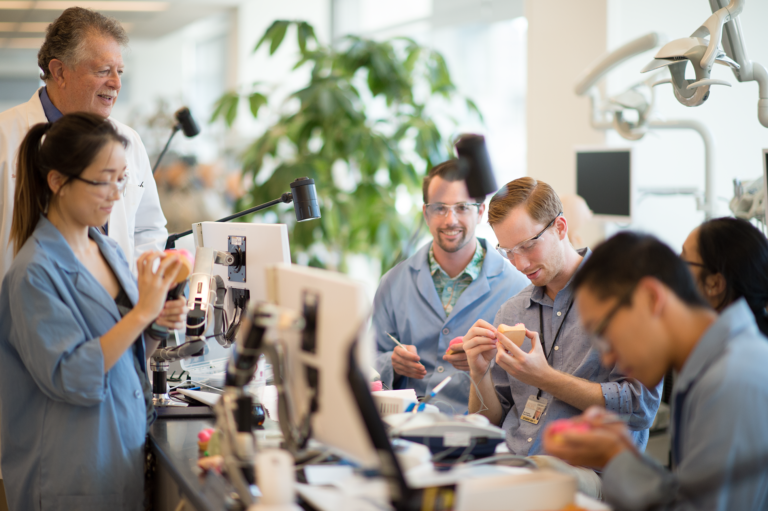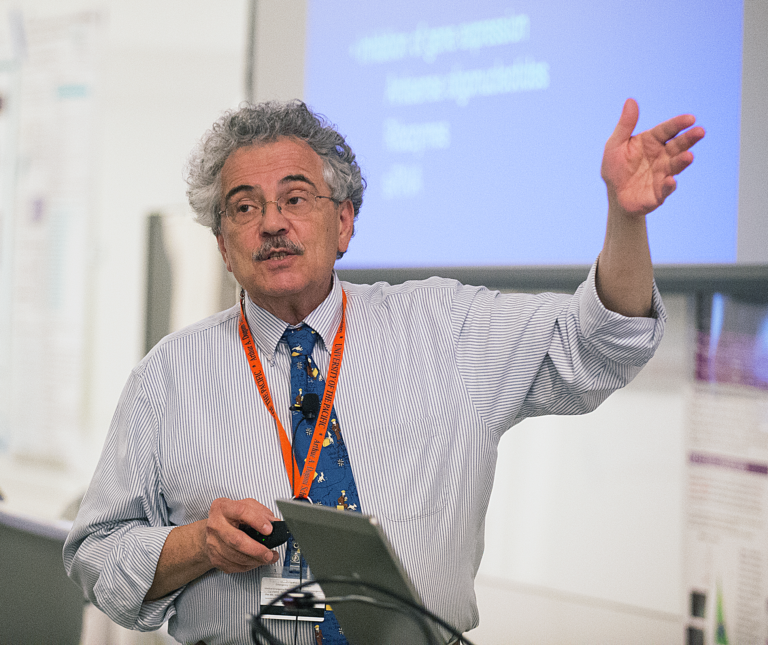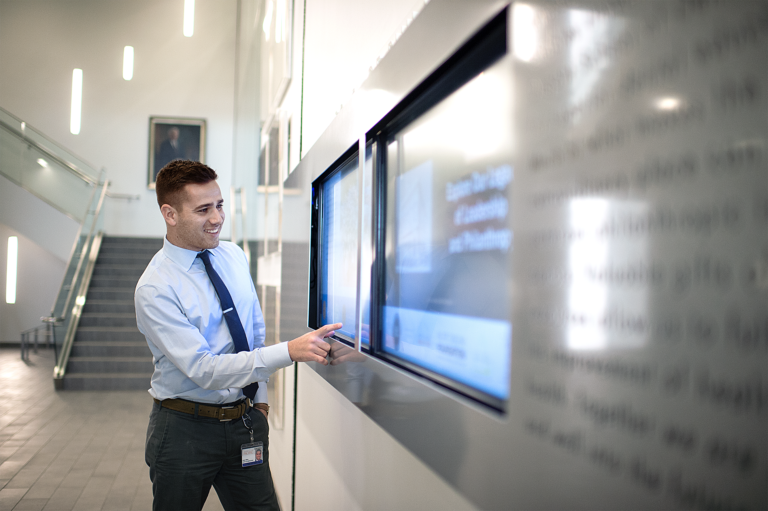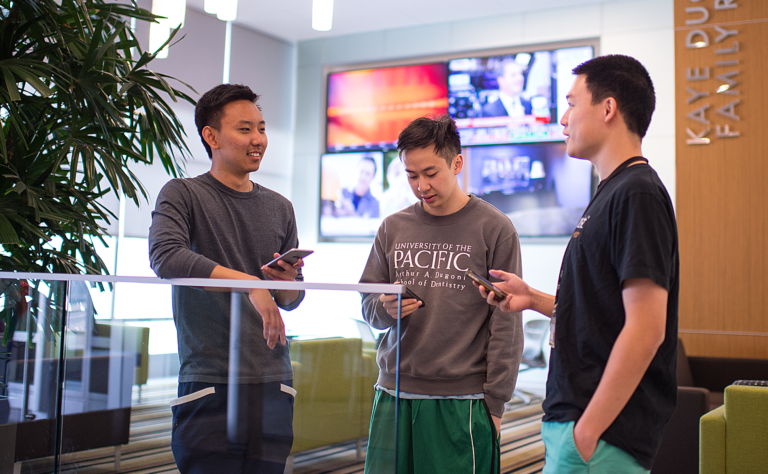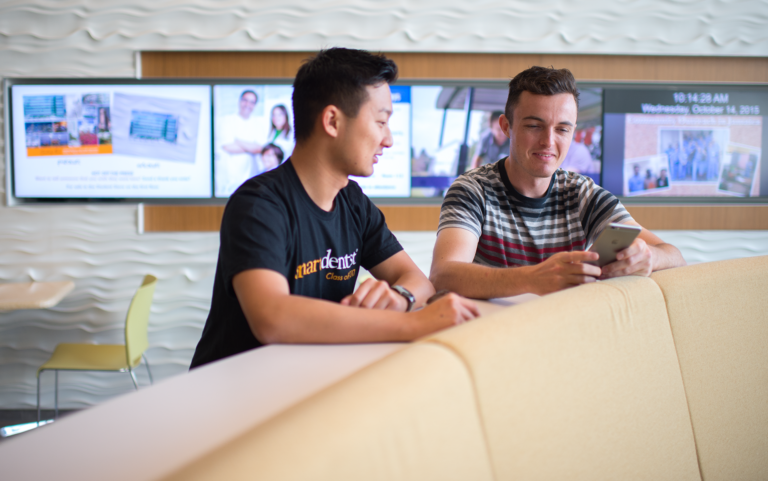WOW, what a magnificent new building. And, the technology to go with it. Imagine a faculty lecturer being able to get real-time feedback from students who merely touch a personal device and the cumulative results appear instantly. Great for testing, stimulating discussion and keeping students involved.
Well, we’ve come a long way since those primitive days of wood-burning computers. That was Room 411 in the building in Pacific Heights back in 1967. There was a tangle of wires under the floor connecting little dials in the armrests of students’ seats to display dashboards on the lectern. We were so far ahead of the times that no one knew how to use that functionality, and it quickly fell into disrepair.
The current building at 155 Fifth Street is a marvel. Its physique is striking. But one might be dazzled by the elephants, marching bands and baton twirlers and miss the parade, unless the focus is on the deep innovation here which is fundamentally digital. We have a new nervous system in the building. That, to a much greater extent than the layout of faculty workstations and clinic operatories, is what is changing the way the Arthur A. Dugoni School of Dentistry does dental education.
And we are unlikely to repeat the mistake of Room 411 because technology is now a pervasive part of our culture; digital savvy is broadly distributed across students, staff and faculty and there are almost no wires to get tangled. Literally, we do not do dental education the same way anymore. And the relationships between us are shifting, even down to re-interpreting our core value of humanism.
It’s All a Laboratory
Let’s start where students first feel like they are doing dentistry—the simulation lab. Dr. Parag Kachalia ’01, vice chair of preclinical education, technology and research in the Department of Integrated Reconstructive Dental Sciences and lead designer of the preclinical facility, turns slightly sideways when he hears this term. “We are not simulating a laboratory; we are simulating the full clinical experience. In every detail possible, the delivery system for first-year students is identical to what they will be using in the clinic, and we hope when they begin practice.” The computer system is the same in both places (students’ manikins are registered clinic patients), the high-torque electric handpieces are also the same and manikins have features such as cheeks and tongues. They are designed with space for computer boards which can be programmed to emulate conditions such as gagging and health limitations.
[pullquote]We have a new nervous system in the building. That, to a much greater extent than the layout of faculty workstations and clinic operatories, is what is changing the way the Arthur A. Dugoni School of Dentistry does dental education.[/pullquote]
The physical configuration is a U shape—there are eight of them with 18 students each. This shape mirrors the group practice concept used in the clinic (although clinic groups are multi-year) and allows for teaching “in the round.” The electronic instructional platform in the lab has the full complement of camera, PowerPoint and video and Internet access one would expect. But there is a common feature to educational technology in the lab, clinic, lectures and seminar rooms. Everything is tri-level: presentation and access can be instantly customized and delivered to the entire class, groups within the class or the individual student.
The context matters as well. Next to the lab is a grading room. Students slide their projects into numbered cubbies, faculty members retrieve them and work around a table to grade the projects, then replace them in the cubbies. It is expected that this will disappear or be modified, as it is hoped that grading in the future will be digital. For students, there are polishing labs and a wet lab (no busier than they were at 2155 Webster Street) and these too will be replaced with digital impressions and milling. Instead there will be a digital design lab. One ancillary area that will likely remain is the student lounge immediately off the lab. Food, conversation and personal computers will stay. There is even a photocopy machine—unremarkable, except for those of us who can remember the days when administrators had to request photocopying privileges, and only a few got them.
Kachalia gives a grin as he summarizes what this new facility represents. “There is one sense in which it is correct to call this a lab. The faculty members are continuously experimenting to determine the best ways to teach preclinical dentistry. If you come back a year from now, it will be different, maybe sooner, but certainly improvement is constant.” The amount of input received in designing the facility was enormous, both in volume and range of sources. The school partnered with students, staff and faculty, and even with vendors. In fact, there is a standing weekly meeting with the company that did most of the design work because they want to know what is working and what is not. Our students have never been shy about letting us know what might be done better. Because our basic structure is small group configurations and complete digital connectivity, everyone is in the center, and everyone participates in continuous improvements. Very humanistic.
Patient Access
Possession of information is not as important as access to it. The same is true for this building. Patients are in certain areas of the building. Students are in other places, and there is even a floor for faculty and administration. Access is controlled by swiping one’s identification card.
Patients have their own entrance to the building and are greeted by staff and are issued a pass at a computerized kiosk. Taking the escalator to the second floor, they can expect to be greeted by their student dentist who was alerted to their arrival by the kiosk. All records are digital, and there are computer monitors for both students and patients. Faculty members have ID cards to swipe. Radiographs are digital, and soon other aspects of care such as impressions will be digitized. Students can now access their segments of the Axium computer clinic management and patient record system from their laptops anywhere in the building.
[pullquote]All records are digital, and there are computer monitors for both students and patients. Faculty members have ID cards to swipe.[/pullquote]
The image of students and faculty members lugging around carousel trays of slides or backpacks full of models and notes would be a bit anachronistic. It would not even be correct to think in terms of students and faculty carrying computers filled with the information they need. A better image is that we carry access devices that have wireless connections to information that exists “somewhere.” Occasionally, it is necessary to plug into a display device, as when giving a presentation. But the metaphor is what we need to know is “there” and is rich, publicly owned and constantly being updated. We do not even have to do the updating. The challenge is access, and that is expanding dramatically.
I Never Did Know Exactly What Didactic Meant
All lectures are on PowerPoint or Keynote when presented, but usually are posted on Sakai, a learning management platform, ahead of time and the actual delivery is archived on a system called Dental Lecture Capture. This is supplemented with study guides, schedules, information about test coverage and links to related material not produced at the Dugoni School of Dentistry posted by faculty and students. Students know, for example, that they can use the Internet to access the collection of histology slides at several universities (for free) or look up Centers for Disease Control and Prevention reports on the connections between heart disease and periodontitis that may be more current than the PowerPoint presentations faculty prepared last month.
In the education system for which the old school on Webster Street was built, it made some sense to talk in terms of learning 80% or 90% of what an instructor said. That is largely meaningless today, except in the vestibular ritual of multiple-guess tests.
Our two large lecture rooms are vastly superior to anything a CE speaker could expect at modern convention centers. The multiple large screens across the front of the room can handle up to four different input streams at the same time from as many as six media sources. In addition, there are television screens throughout the lecture and seminar rooms to support breakout groups. Most of this technology is “plug and play” in the sense that the expert connects his or her electronic device to the system and is off and running. No, we did not get rid of blackboards in the seminar rooms. Except they are now white, and many work with colored pens, automatically project to large screens and erase themselves with one click. The days of students crowding to the front of the room to grab a copy of the handout are, of course, gone. If it is not online, there is a serious possibility that it does not exist.
[pullquote]Our two large lecture rooms are vastly superior to anything a CE speaker could expect at modern convention centers. The multiple large screens across the front of the room can handle up to four different input streams at the same time from as many as six media sources.[/pullquote]
More Can Play
The old model was that information was transmitted from faculty to student. The new model is that faculty and students sit around a virtual table covered with content. But there is a new player in the building on Fifth Street. Staff members have assumed a role in education that goes well beyond the old days of typing course outlines, handouts and final exams. Not that long ago, staff members drew their power primarily from controlling access to faculty members. Virtually every course strand in the curriculum now has a staff facilitator (not a faculty member) who helps manage student learning. Just the business of arranging multiple small group meetings in the building involves one full-time employee, plus the discipline-based staff. It is all electronic, down to green and red digital displays near huddle room doors. The Department of Information Technology, once three brave souls, now has a broad range of experts in many areas, often in direct and continual contact with students and faculty. The number of staff at the dental school has increased 15% in the past five years. Staff members have assumed new importance, and we could not implement technology as we do without them.
Students Are Different
Students tend to see technology a different way than the administration and faculty do. It is not so much about content and transmission of information as it is about participation. It is also about options and connectivity.
Students are motivated to navigate the rich environment of learning opportunities. And just as there are some students with strong biomedical backgrounds and some with natural mechanical ability, there are differences in digital literacy. Some, after all, have graduate training and work experience in IT. But it is the network that matters. Every student has access to the digital tools provided by the school; but most go well beyond that. Facebook is used for sharing class notes, tips about additional material, social events and community service opportunities, interpretations of clinical protocol, appeals for help and venting and humor. Most students have multiple Facebook accounts: some for general broadcast information, some for school business of various sorts and even exclusive accounts. Some are open and some are moderated. Students may organize files by discipline content, as the curriculum and faculty are organized. But they are also organized by media and student life experiences. In the clinic, the computer is centered on the patient experience, not on requirements.
Students learn much of how the digital world works from classmates. The Dugoni School of Dentistry was one of the first dental schools to issue laptop computers to students in the 1990s. In the early days, we insisted that only a single type of school-issued device was allowable, and the faculty voted not to install electrical outlets on the seats when remodeling a classroom because “who knew what students might be doing on their laptops when they were supposed to be listening to the lecturer?”
Access matters to students; and so does redundancy. The usefulness of media content is dependent on being able to get to it in a useable format at the time it is needed. In my interviews with students, the quality of content of instruction was never mentioned—it is assumed. What seems to matter is being able to download content to devices that fit various students’ personal styles and are familiar to them. Having two monitors in each clinic operatory is excellent. One is for the patient, and they will be shown reruns of old sitcoms or homecare instructions, both found by the student from YouTube rather than provided by the school. The other is for the student-dentist. Two monitors are good in the preclinical technique lab as well. One is for faculty members presenting information; the other—in line of sight for students while operating—provides moment-to-moment support.
New Relationships
A cynic might question whether students really do learn more content or get it better than was done in the good old days. Of course, we knew most of the answers to these questions decades ago. In the 1970s, a typical research article in the Journal of Dental Education compared student learning in various media formats. We found that media does not matter as long as faculty control the experience. We also did studies when various platforms such as Sakai were introduced to host course content. We found that students glance at newly posted material to see whether it is of value and spend a bit more time with the resources immediately prior to examinations. National Board scores are largely unchanged.
But all of this misses the point. We have a new relationship with information and a new relationship with each other. Learners (and that would include faculty members) can change what they know more quickly these days. That matters a lot because dentistry and the context in which it is practiced are changing at an ever-accelerating pace. It is no longer high praise to say that Professor Centric is the most knowledgeable individual on occlusion in the whole building. Students now have and expect to have a more responsible role in acquiring and managing their learning. They also know that that information is “somewhere,” and they are pretty good at getting it.
What the speed and complexity of information technology has forced on us is a democratization of knowledge. The concept of an expert is drifting; clock hours are losing their meaning as a measure of knowledge. Humanism has gone digital because what we need to know is no longer tightly controlled by a few. We are gaining the technology to break down traditional barriers and allow more people to participate in the advancement of dental education.
Remember that old tangle of wires in Room 411 that was a showcase for progressive technology in the “new” building on Webster Street? That was then and there. We did more than move to a new building.
We are erasing time and space in dental education.
David W. Chambers, PhD, is a professor of dental education and former academic dean at the Dugoni School of Dentistry, and is editor of the American College of Dentists.

